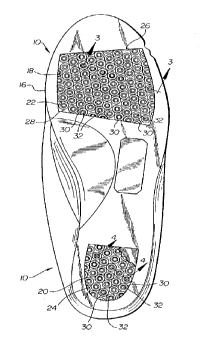Note: Descriptions are shown in the official language in which they were submitted.
213~ 8~
- PATENT
SHOE INSOLE
This invention relates to an insole for use in a sport
shoe and is particularly adaptable for use in a riding shoe.
OBJECTS AND SUMMARY OF THE INVENTION
A principal object of the invention is to provide in
a cushion insole system for use in a sport shoe an insole which
has superior shock absorbing characteristics and substantial
cushioning capabilities.
Another object of the invention is to provide a
cushioning material which is of such construction that in use it
will contribute to a foot massaging effect which is very
desirable in shoes used in athletic activities.
A further object is to fashion an insole of such
material and construction that will provide extra cushioning and
shock absorption for the foot in a stirrup while riding.
Additional objects and features of the invention will
become more apparent from the following description and
accompanying drawings.
2~31838
BRIEF DESCRIPTION OF THE DRAWINGS
Fig. 1 is a top plan view of an insole embodying the
invention herein;
s
Fig. 2 is a bottom plan view of the insole of Fig 1;
Fig. 3 is a partial enlarged sectional view in
elevation taken along line 3-3 of Fig. 2; and
Fig. 4 is a partial enlarged sectional view in
elevation taken along line 4-4 of Fig. 2.
DESCRIPTION OF THE PREFERRED EMBODIMENT
Referring now to the drawings wherein like reference
characters refer to like parts, Figs. 1 and 2 show a flexible
insole 10. The insole 10 includes a layer 12 of moisture wicking
material which is permanently bonded to a foam backing 14. The
backing 14 in turn is bonded to a high density EVA foam footbed
16. Resilient pad means are secured to the underside of the foam
footbed 16 and includes first and second resilient pads 18 and
20. The moisture wicking material helps to soak up perspiration.
The resilient pad means provide additional cushioning and shock
absorption at those portions of a foot which rests on this pad
means.
The first resilient pad 18 is secured to the underside
of the foam footbed 16 at the forward end or the forefoot of the
insole 10. The second resilient pad 20 is secured to the
underside of the foam footbed 16 at the heel end of the insole
10. While the pads 18 and 20 could be secured to a footbed
having a flat surface, preferably they are disposed respectively
in cavities 22 and 24 formed in the bottom surface of footbed 16.
These cavities or foundation pockets, as they are sometimes
referred to, assist in holding the pads 18 and 20 in place in
their predetermined positions in association with the foam
2131838
footbed 16. The pads 18 and 20 are adhesively secured in the
cavities 22 and 24.
It will be observed from Fig. 2 that the forward
portion of pad 18 is truncated and that the forward edge 26 of
pad 18 does not extend all the way to the forward edge of the toe
portion of the insole footbed 16, i.e., it does not extend over
the portion of the insole where the toes would normally rest.
The resilient pads preferably are made of a relatively
stiff elastomeric compressible rubberlike or gel material such,
for example, as a PVC material. These pads function as a
cushioning and shock absorbing material capable of withstanding
substantial repeated shocks to the foot, such, for example, as
stirrup shocks experienced by a rider when engaged in horseback
jumping activities or other riding activities.
The resilient pads 18 and 20 each include a sheet-like
base portion 28 and a plurality of frusto-conical shaped primary
nubs 30 formed integrally with the sheet-like base portion 28.
A small substantially hemi-spherically shaped secondary nub 32
is formed integrally with, and depends from, each primary nub.
The secondary nub is disposed coaxially with the primary nub.
It will be noted that the secondary nubs are of a smaller
diameter than the lower surface of the frusta to which they are
attached.
Although these resilient pads may be made with
different size nubs we have found that a construction with the
following approximate dimensions yields a product which is highly
satisfactory.
The resilient pads are constructed with approximately
four primary nubs per linear inch. Each of the primary nubs 30
is approximately 3/16" in diameter at its base, i.e., where it
intersects with the base portion 28. The overall height of the
primary and secondary nubs together may be approximately 1/8".
21~183~
- Because of a certain lateral flexibility of the primary
nubs, which is assisted by the direct almost pinpoint-like
contact of the smaller secondary nubs with the foot, a beneficial
secondary effect, namely a massaging effect on the foot occurs.
While a preferred embodiment of the invention has been
disclosed, it will be appreciated that this is shown by way of
example only, and the invention is not to be limited thereto as
other variations will be apparent to those skilled in the art,
and the invention is to be given its fullest interpretation
within the terms of the following claims.
